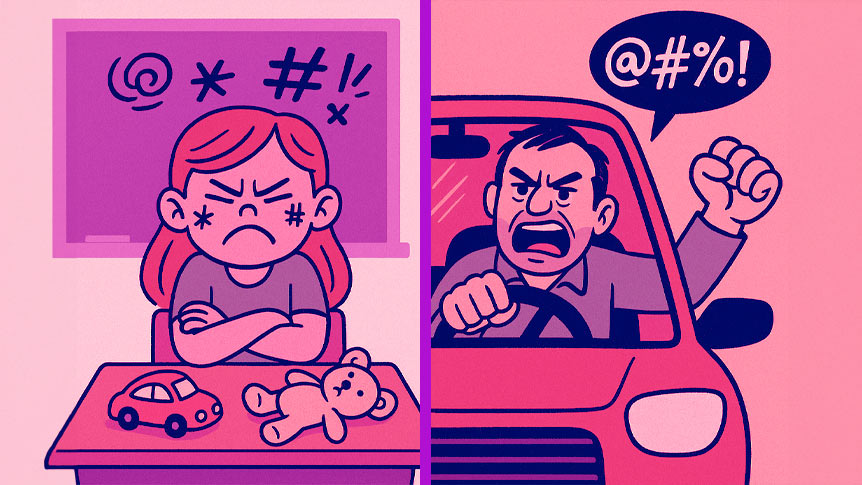This is a tongue-in-cheek look at the gap between theory and real life, not a knock on hardworking teachers.
The Hook & Irony
Public school systems pour significant money into professional development every year—often thousands of dollars per teacher—trying to train teachers how to handle meltdowns, as if a magic script could stop a five-year-old from going nuclear in the middle of math class. The training usually boils down to one strategy: stay calm, and tell the child to calm down.
Here’s the problem: that’s the worst phrase in human history to throw at someone who’s already pissed. If you’ve ever told an adult to “calm down” while they were mid-meltdown, you know what happens next, you get fire-breathing rage, not peace.
Adults lose it all the time. They yell, slam doors, send toxic emails, curse in traffic, or threaten to quit jobs they’ll still clock into on Monday. Kids do the exact same thing, just without the professional filters. They scream, throw things, cry, and say the meanest stuff they can think of.
The difference? When adults melt down, we call it “having a bad day.” When kids melt down, we call in the laminated manual. And that’s the irony: we’re spending millions training teachers to manage kids like they’re glitchy robots that need rebooting, while adults out here are throwing their own tantrums with nobody handing them a juice box.
The Kid-Written Teacher Training Manual
If the adults who design teacher trainings had to survive their own advice during a full-grown meltdown at Costco, those binders would be in the trash tomorrow.
So let’s imagine the opposite: what if kids got to write the manual? No pastel PowerPoints. No “deep breathing together.” Just raw, tested-in-the-field tactics from the true meltdown experts.
The Prime Directive
- Never say “calm down.” That’s a banned phrase.
- Instead, try one of the following:
- “Want a snack?”
- “Wanna draw something weird?”
- “Need to scream into a pillow real quick?”
The Sacred Tools
- Apple Juice Box – portable reset button, bendy straw mandatory.
- Cookies – chocolate chip or bust. Raisins = betrayal.
- Crayons – 64-pack minimum. Half the therapy is peeling the wrapper.
- Blank Wall – safe stare space, free of motivational kitten posters.
Rules of Engagement
- Don’t lecture mid-meltdown. Words bounce off like Nerf darts.
- Offer space, not shame.
- Respect the Cookie Truce: once the cookie is accepted, all hostilities are null and void.
Advanced Tactics
- The Distraction Maneuver: mention dinosaurs, fart jokes, or Minecraft. Works on 97% of children and 74% of adults.
- The Squiggle Transfer: “Draw your anger monster.” Turn chaos into art.
- The Chill Blanket: optional cozy blanket = emotional reset mode.
For Adults Only
- Juice becomes coffee.
- Cookies become pizza.
- Crayons stay.
- (Don’t knock it till you try it.)
Wisdom Clause
Kids aren’t glitchy robots. They’re just small humans practicing emotions out loud. Adults are big humans practicing emotions in secret. Same operating system, different interface.

What If PBIS Scripts Were Used on Adults?
Here’s the thing: PBIS (Positive Behavioral Interventions and Supports) and Responsive Classroom trainings aren’t evil. They’re built on neuroscience that actually makes sense. Brains in meltdown mode can’t process logic, so calm is contagious. But the way the scripts get written? Man, they’d never survive the real world.
So imagine taking those “kid-tested” lines and dropping them into an adult meltdown:
- “I’m here for you.”
Try saying this to a grown adult screaming in traffic court and you’ll get, “WHO ASKED YOU TO BE HERE?!” - “Let’s breathe together.”
Great in yoga class. In the middle of Costco when someone just found out their favorite coffee’s discontinued? Cult vibes. - “Use your words.”
Translation: stop expressing yourself that way, and start using the words I approve of. Try that on a furious coworker: “Karen, use your words.” Goodbye teeth. - “I can see you’re upset.”
Groundbreaking observation, Sherlock. - “Would you like to take a break?”
In school: “calm corner.” In adult land: “time-out.” Congratulations, you’ve escalated the fight. - “We’ll wait until you’re ready.”
Pure passive-aggression when aimed at an adult mid-rage. - The Silent Teacher Stare
Try that on your boss. Spoiler: it ends with “WHAT?!”
This is the paradox: the science is solid, but the delivery is absurd. On paper it’s “co-regulation.” In practice, it often feels like control disguised as empathy, and that’s where kids (and adults) bristle.
The Real Talk Turn
Let’s be fair: PBIS and Responsive Classroom aren’t completely wrong. They just get lost in translation. The neuroscience behind it is solid—when someone (kid or adult) is in meltdown mode, their “thinking brain” (prefrontal cortex) goes offline, and their “alarm system” (amygdala) is running the show. That’s why reasoning or lecturing doesn’t work mid-tantrum. It’s like trying to install a software update on a laptop while it’s literally on fire.
So what does work? Here’s the honest truth:
- Don’t out-shout rage. Shouting over a meltdown is like throwing gasoline on flames.
- Be firm without being cruel. Boundaries matter more than threats.
- Don’t script, be human. “I get you’re mad” beats “I can see you’re upset.”
- Offer space, not abandonment. Presence without smothering is the sweet spot.
- Know when to put your foot down. Firmness isn’t rage; it’s stability.
- Reset the body to reset the brain. Snacks, doodling, or a walk all help the body calm before the brain catches up.
The irony is, PBIS got the “stay calm” part right. What they often miss is the tone. Calm doesn’t mean robotic. Stern doesn’t mean cruel. Real authority lives in the middle: steady, human, firm when needed, soft when possible.
The Middle Path
There are two extremes that make meltdowns worse:
- Too calm, too scripted: You sound like a meditation app trapped in a body.
- Too harsh, too reactive: You match their fire with your own and leave scorch marks on the relationship.
The real skill sits somewhere between.
Stern without cruel
Stern is “Here’s the line, and I’m holding it.” Cruel is “Here’s the line, and I’ll make you feel small for crossing it.” Kids respect the first. They resent the second.
Calm without robotic
Calm isn’t monotone or detached. It’s steady, unshakable, and human.
Firmness as protection, not punishment
Sometimes calm doesn’t work. Firmness keeps everyone safe without crushing a child’s will.
Flexibility in real time
Here’s the part the manuals can’t teach: sometimes you lead with calm, sometimes with humor, sometimes with silence. It’s jazz, not sheet music. And jazz only works if the person playing trusts their instincts.
Teachers know this already in their bones. They just rarely hear it acknowledged. Too often the system tells them, “Smile more, be calm, follow the script,” or “Don’t back down, show them who’s boss.” Both miss the mark.
The truth is, the best teachers know how to hold a boundary with strength and humanity at the same time. And that middle path—stern without cruel, calm without fake—takes more skill than any binder can capture.
Encouragement for Teachers
Here’s the part no laminated manual ever says out loud: this is hard.
Teaching isn’t just delivering lessons. It’s standing in front of 15 nervous systems, all buzzing with their own stress, hunger, joy, trauma, excitement, and chaos. Some days it feels like conducting an orchestra. Other days it feels like refereeing a bar fight. And most days, it’s both before lunch.
Meltdowns aren’t a sign that you’re failing. They’re a sign that kids are human. Humans explode sometimes. Adults do it behind closed doors, with slammed car doors, passive-aggressive emails, or sharp words at the wrong person. Kids do it out loud, with crayons and tears.
The fact that you’re there—showing up, holding space, setting limits, staying steady—that matters more than any script.
Sometimes calm works. Sometimes it doesn’t. Sometimes firmness works. Sometimes it doesn’t. And sometimes, nothing works in the moment, and all you can do is ride out the storm. That doesn’t mean you got it wrong. It means you’re human, too.
You don’t have to be a robot or a drill sergeant. You don’t have to fix everything in the moment. You don’t have to have the perfect line ready. What kids need most is what you already bring: someone who won’t disappear when things get messy, someone who won’t fight fire with fire, someone who can be the steady center when the world feels out of control.
That doesn’t come from a manual. It comes from you.
So laugh at the binders. Laugh at the trainings that think meltdowns can be solved with pastel slogans. Then keep doing the harder, braver work of showing up as a real human in the middle of real chaos.
Because here’s the truth: no juice box, no cookie, no script will ever matter as much as the fact that you’re there.

